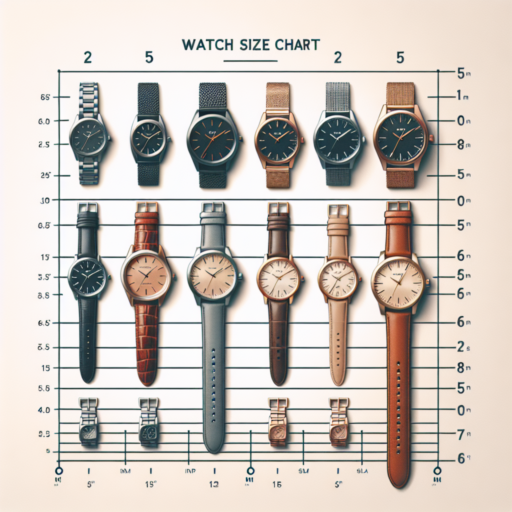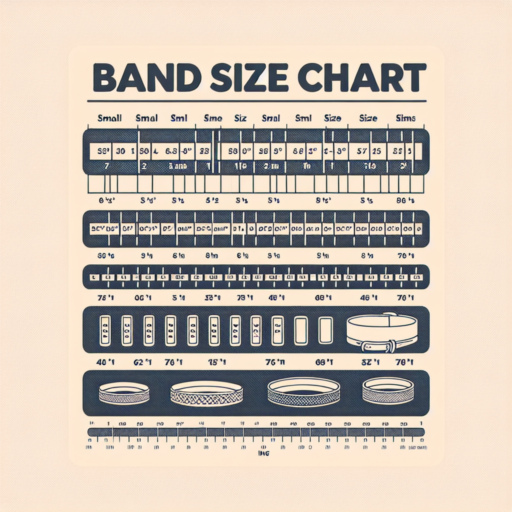Understanding Watch Size Chart: A Comprehensive Guide
When it comes to selecting the perfect timepiece, understanding the watch size chart is crucial for both comfort and style. The watch size chart refers to the dimensions of the watch face or dial, usually measured in millimeters (mm), which is a significant factor in determining how a watch will look on your wrist. Navigating through this chart can help you find a watch that not only fits perfectly but also complements your wrist size and personal style.
Case Diameter is the most noticeable aspect of a watch’s size and plays a pivotal role in its overall appearance. Case diameters can range from petite 26mm sizes suitable for smaller wrists, up to bold 46mm sizes for a more statement look. However, the most common sizes for men’s watches fall between 38mm and 42mm, while women’s watches typically range from 26mm to 34mm. It’s essential to choose a diameter that balances well with your wrist size; too big, and the watch might look overwhelming, too small, and it might appear delicate.
Case Thickness is another important dimension represented in the watch size chart. It refers to how thick or thin the watch case is from the back where it rests on your wrist to the top of the crystal. Case thickness often correlates with the case diameter, meaning larger watches tend to have thicker cases. However, for those seeking a more subtle and elegant look, opting for a thinner watch might be preferable. Thinner watches are not only more comfortable but can also slide under a shirt cuff more easily, making them ideal for formal occasions.
Finally, while the Lug Width and Strap Width might not directly impact the choice of size, they are essential for ensuring the watch fits the strap perfectly, contributing to the overall comfort and style of the watch. These measurements are especially crucial when looking to replace or customize your watch strap. A mismatch between the lug width and strap can result in an improper fit, detracting from the watch’s appearance and wearability.
How to Measure Your Wrist for the Perfect Watch Size
Measuring your wrist for a watch is a crucial step to ensure that the watch not only fits comfortably but also looks proportionate to your wrist. Whether you’re buying a watch online or picking one from a store, knowing your wrist size will help you make an informed decision.
Tools You Will Need
Before you begin the measurement process, you’ll need a flexible tailor’s tape measure. If you don’t have one, a piece of string or ribbon and a ruler will work just as well. Ensure that the tape measure or string can wrap around your wrist smoothly without causing indentation.
Steps to Measure Your Wrist
- Wrap the tape measure around the wrist you intend to wear the watch on. This should be done right where the wrist meets the hand, on the narrower part of your wrist.
- Make sure that the tape measure is snug but not tight. You should be able to slide a finger under the tape measure easily.
- If you’re using string, mark the point where the end meets the string around your wrist, then lay the string straight and measure the distance with a ruler.
- Note: Record the measurement in inches or centimeters, depending on your preference or the sizing guide of the watch you’re interested in.
Selecting a watch that fits your wrist perfectly enhances not only comfort but also the appeal of the watch on your wrist. Armed with your wrist measurement, you can confidently shop for a watch that suits your style and fits your wrist like it was made just for you.
The Importance of Watch Case Diameter in a Watch Size Chart
Understanding the watch case diameter is crucial when navigating through a watch size chart. It represents more than just a mere number; it influences the overall aesthetics, comfort, and readability of the timepiece. The case diameter is one of the first aspects to be noticed in a watch, determining how the watch sits on the wrist and aligns with personal style preferences.
The case diameter plays a pivotal role in ensuring a perfect fit. A watch that is too large can appear overpowering on a smaller wrist, while one that is too small may look disproportionate on a larger wrist. Thus, the watch case diameter serves as a primary guide for finding a timepiece that compliments the anatomy of the wearer’s wrist. This balance between the size of the watch and the wrist size enhances both comfort and style, making the selection of the correct case diameter essential.
Key Considerations for Choosing the Right Case Diameter
- Wrist Size: Measuring your wrist can help you determine the appropriate watch case diameter that ensures the watch looks proportionate.
- Watch Style: Different styles may influence the perceived suitability of case diameters. For example, dress watches often look better with a more subtle and smaller case diameter.
No se han encontrado productos.
Deciphering Lug-to-Lug Distance for the Right Watch Fit
Understanding the lug-to-lug distance of a watch is crucial for finding a piece that sits comfortably on your wrist. This measurement, often overlooked in favor of case diameter, is actually the key to ensuring the watch doesn’t hang over the edges of your wrist, creating an uncomfortable or awkward fit. By focusing on the lug-to-lug measurement, you can ensure a harmonious balance between your watch and wrist size, enhancing both comfort and aesthetic appeal.
The lug-to-lug distance is defined as the length from the top to the bottom of the watch’s case, including the protrusions where the strap or bracelet is attached. This dimension dictates how the watch will span across your wrist, an aspect particularly important for individuals with narrower wrists. A watch with a short lug-to-lug distance might be perfect for smaller wrists, ensuring the watch sits snugly without extending beyond the wrist’s edges, while a longer lug-to-lug may complement larger wrists better.
To accurately measure the lug-to-lug distance, you can use a ruler or a digital caliper. Place the measuring tool directly on the watch’s lugs, ensuring it spans the entire length from one end to the other. It’s this measurement, combined with your wrist size, that will guide you towards a perfectly fitting watch. Remember, while a watch’s case diameter offers a visual clue to its size, it’s the lug-to-lug distance that truly determines how it will fit on your wrist.
Band Width: An Essential Aspect of Watch Sizing
The importance of band width in the overall aesthetics and comfort of a watch cannot be understated. This critical element defines not just how a watch looks on your wrist but also how it feels throughout the day. For both enthusiasts and casual wearers alike, understanding the nuances of band width could greatly enhance your watch-wearing experience.
At its core, the band width of a watch refers to the measurement of the strap or bracelet that connects to the watch case. This dimension is usually measured in millimeters and can significantly influence the overall appearance and wearability of a timepiece. A well-chosen band width complements the watch case size, ensuring a balanced look that is neither too bulky nor too delicate on the wearer’s wrist.
Moreover, the suitability of a certain band width also varies depending on personal preference and wrist size. For individuals with larger wrists, a wider band may provide a more proportional and comfortable fit. Conversely, those with slender wrists might find narrower bands more flattering and comfortable. It’s all about finding the right balance that works for you, highlighting why band width is not a one-size-fits-all aspect of watch sizing.
Women’s vs. Men’s Watch Size Chart: Key Differences
When exploring the intricate world of wristwatches, the disparity in watch sizes between genders becomes a notable topic. Understanding the key differences in watch size charts for men and women can greatly enhance the shopping experience, ensuring you find a timepiece that not just fits your wrist perfectly but also aligns with your style preferences. The distinctions often lie in the case diameter, case thickness, and the band width, all of which contribute to the overall presence of the watch on the wearer’s wrist.
In general, men’s watches tend to boast a larger case diameter which typically ranges from 38mm to 46mm. This size not only enhances readability but also makes a bold style statement, fitting the broader wrists of men comfortably. Meanwhile, women’s watches often feature a daintier design, with case diameters ranging from 26mm to 34mm. This size ensures the watch remains proportional to the usually narrower female wrist, offering a more delicate and sophisticated appearance.
The case thickness and band width further accentuate the differences between women’s and men’s watches. Men’s timepieces often come with a thicker case and wider band, which complements the larger overall size and provides a robust feel. On the contrary, women’s watches prioritize elegance and subtlety with slimmer cases and narrower bands, enhancing the jewelry-like appeal of the watch. It’s these detailed differences in dimensions that underscore the diversity in design preferences and practical needs across genders.
Common Watch Sizes and How to Choose Yours
Choosing the right watch size is crucial for comfort, style, and functionality. Watches come in a variety of sizes, and understanding the common dimensions can help you find the perfect fit. Watch size typically refers to the watch case diameter, measured in millimeters (mm). Men’s watches generally range from 38mm to 46mm, though larger options exist for those seeking a more pronounced presence on the wrist. Women’s watches tend to be smaller, ranging from 26mm to 34mm, offering a more delicate and subtle aesthetic.
Determining the ideal watch size for your wrist involves considering your personal preference and the watch’s lug-to-lug measurement. This measurement is as crucial as the case diameter because it affects how the watch will sit on your wrist. A watch with a lug-to-lug measurement that exceeds the width of your wrist may overhang, potentially leading to discomfort or an undesirable look. For a balanced appearance, look for a watch whose case size and lug-to-lug measurement harmonize well with your wrist size.
Aside from measurements, the watch style also plays a significant role in choosing the right size. For example, a dress watch might appear best in a more conservative size range, such as 34mm to 40mm for men and 26mm to 33mm for women, to maintain an elegant and understated look. On the other hand, sports and tactical watches often benefit from larger cases, not only for aesthetic reasons but also to accommodate additional features like chronographs and tachymeters.
Adjusting Your Watch Strap: Tips for a Perfect Fit
Ensuring your watch fits perfectly isn’t just about comfort; it’s also about maintaining the integrity of your timepiece and enhancing its aesthetic appeal. Whether you’re working with a leather band, a metal bracelet, or a synthetic alternative, the key is understanding the nuances of your material and the adjustment techniques that align with it. In this segment, we’ll delve into practical tips for achieving a snug, tailored fit for your watch strap.
Understanding Strap Types and Their Adjustment Mechanisms
Different types of watch straps demand specific methods of adjustment. For instance, metal bracelets typically feature a pin-and-tuck closure or a fold-over clasp that can be resized by adding or removing links. On the other hand, leather straps often incorporate a buckle mechanism, similar to a belt, which allows for a broad range of size modifications. Synthetic bands, such as those made from silicone or rubber, might offer a pin-and-hole arrangement or a clasp system. Familiarizing yourself with your strap’s particular adjustment mechanism is the first step toward a perfect fit.
Tools You Might Need for a Custom Fit
Adjusting your watch strap might require specific tools, especially for metal bracelets. A pin removal tool or a small screwdriver can be indispensable for adding or removing links. Alternatively, for leather or synthetic straps, you might only need a simple hole puncher to create additional buckle holes for a tighter fit. It’s vital to approach this process with patience and the right tools to avoid damaging your strap or the watch itself.
In summary, ensuring your watch strap fits perfectly is crucial for both comfort and function. Whether you’re tweaking a leather strap, resizing a metal bracelet, or adjusting a synthetic option, the right tools and techniques are key. By paying close attention to the type of strap you have and its unique adjustment mechanisms, you can achieve a personalized, perfect fit every time.
FAQs on Watch Sizing: Everything You Need to Know
When it comes to selecting the perfect watch, understanding the intricacies of watch sizing is crucial. Many people often overlook this aspect, leading to purchases that don’t quite fit their style or wrist comfortably. Below, we dive into the most frequently asked questions about watch sizing, providing you with the essential knowledge needed to make an informed decision.
What Determines the Perfect Watch Size?
The perfect watch size is determined by several factors including the diameter of the watch case, the thickness of the case, and the width of the strap or bracelet. However, the most significant factor is the size of your wrist. Watches should feel comfortable, look proportionate, and complement your wrist without overwhelming it. A rule of thumb is to choose a watch case thickness that corresponds directly to the diameter and suits your wrist size and personal style.
How Do I Measure My Wrist for Watch Sizing?
Measuring your wrist for watch sizing is a straightforward process. You can use a flexible measuring tape and wrap it around your wrist at the location where you typically wear your watch. Ensure the measuring tape is snug but not tight to get an accurate measurement. Once you have your wrist size, compare it to the manufacturer’s sizing guide to find your perfect fit. For those who prefer a visual guide, many brands offer printable measuring tools online.
Understanding the nuances of watch sizing can significantly enhance your watch-wearing experience, ensuring both comfort and style. As you explore the vast world of watches, keep these FAQs in mind to guide your journey in finding a watch that not only tells time but also perfectly fits your personal aesthetics and lifestyle.
Top Brands and Their Watch Size Chart Explained
Selecting the perfect watch involves more than just finding a style you love; understanding the size chart is critical to ensure a comfortable fit. Many top watch brands offer their unique size charts, which can include dimensions such as case diameter, case thickness, and band width. These elements are crucial in determining how the watch will sit on your wrist and how it will look proportionally.
Case Diameter: A Key Dimension
The case diameter is often the most highlighted aspect of a watch’s size. Brands like Rolex, Omega, and Tag Heuer showcase a range of diameters in their collections, typically ranging from 36mm for classic models to 44mm for larger, more modern designs. Understanding this measurement is essential for selecting a watch that balances well on your wrist, neither overpowering it nor appearing too subtle.
Case Thickness and Band Width
Equally significant, though sometimes overlooked, are the case thickness and band width. These dimensions affect the overall feel and comfort of the watch. Highly regarded brands such as Patek Philippe and Cartier pay close attention to these measurements to ensure their watches provide an elegant fit. For instance, a thicker case may provide a more robust look, suitable for casual or sporty styles, while a slimmer profile is often associated with elegance and formality.
Understanding the detailed size chart of top brands can significantly enhance your watch-buying experience, ensuring you select a piece that looks and feels just right. Remember, the measurements are not merely numbers; they are a guide to finding a watch that complements your style and fits your wrist perfectly.




